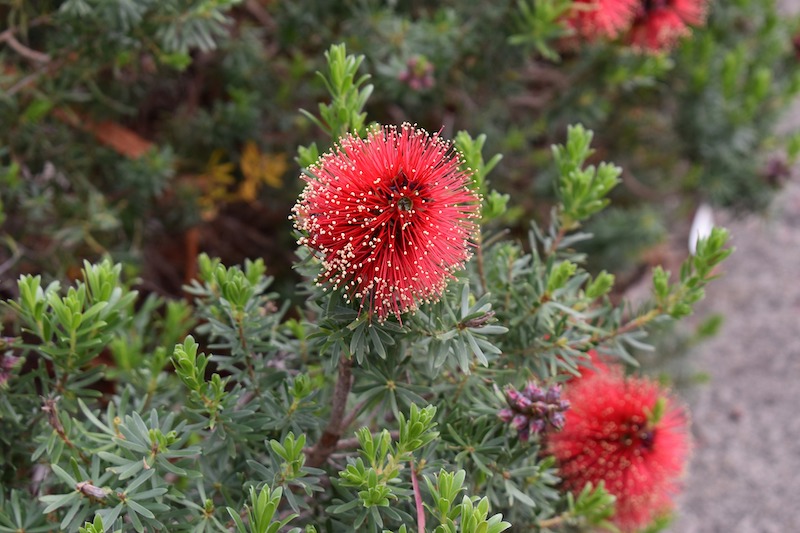Growing Bottlebrush shrubs in containers is a great way to instantly dress up a deck or patio with either a tropical or naturalized look. Callistemon spp. are evergreen and make great specimen plants even in cooler growing climates. The smaller, weeping varieties need less pruning than upright types, although any Callistemon can be pruned to size annually.
Bottlebrush Buckeye, Aesculus parviflora, can be grown for a few years in pots before it will need to be placed in a garden bed.

Planting Bottlebrush in Pots
Container-grown shrubs can be repotted at virtually any time of the year. Callistemon Bottlebrush is evergreen and only hardy in USDA zones 9-11. Repotting in these areas can happen any time the temperatures are between 45-85 degrees Fahrenheit. Repotting during the height of summer will require diligent watering, which can also lead to overwatering if the pots do not have excellent drainage.
Because drainage is so important for Callistemon spp., using a terra cotta pot makes more sense than a plastic or resin pot. Terra cotta helps the root system breathe because of its porous texture. Unglazed clay also is able to withstand the extremely mild winter temperatures of zones 9-11 with no risk of cracking or breaking.
The deciduous Bottlebrush Buckeye will establish quicker when planted early in the spring. The root system grows vigorously after winter dormancy and new growth starts quickly. It will be happiest planted in a nonporous plastic or resin container, which holds moisture longer during the summer and can withstand extreme winter conditions with very little maintenance.
Best Soil For Bottlebrush in Pots
The evergreen Callistemon requires a potting mix with added grit, pumice, or perlite to ensure that the soil is fast draining and not prone to waterlogging at any time of the year. A ratio of 2 parts all-purpose potting mix to 1 part perlite is ideal.
The deciduous Bottlebrush Buckeye prefers soil that holds moisture longer and is richer in nutrients. Mix 2 parts of a peat-free potting mix with 1 part organic compost to keep the root system consistently moist. Add a layer of fine organic material to the top of a large container to help retain moisture and keep the soil cool. Finely shredded arborist chips, leaves, or more decorative pea gravel all work well as mulch.

Caring For Bottlebrush in Planters
Shrubs growing in containers will require extra attention to watering, fertilizing, and winter care. Nutrients are washed out of the soil every time the pot is watered, so a regular schedule of fertilizing is often recommended even for plants that normally need little supplemental feeding. Potted shrubs are also more vulnerable to cold weather and storms, so extra protection can help your containers overwinter successfully outdoors.
Watering Bottlebrush in Pots
Bottlebrush grows best when the containers are allowed to dry out between waterings. Callistemon will require a good soaking once a week to saturate all of the potting soil.
Bottlebrush Buckeye requires more watering, especially during a hot or dry period. Only allow the top 1-2 inches of potting soil to dry in between waterings. Keep in mind that containers placed in shadier locations will dry out slower than a pot in a hot, sunny location.
Fertilizing Bottlebrush in Pots
Bottlebrush will require fertilizing when growing in a container. A granular, slow-release fertilizer will last for up to six weeks before needing to be refreshed. Choose a formulation for flowering shrubs with an NPK ratio approaching 1-3-2. The supplement feeding will support both flowering and foliage development.
Winter Care For Bottlebrush in Pots
Evergreen Callistemon is a sub-tropical shrub only hardy in the USDA zones 9-11. In those zones, the shrubs will stay semi-dormant through the winter, slowing growth but still flowering intermittently until the spring. Callistemon can be grown as a houseplant in colder climates.
Deciduous Bottlebrush Buckeye is much hardier in colder climates and grows best when it is left outside through the winter in its dormant state. Protect the container from harsh wind and winter storms if necessary. The container must continue to drain well through the winter months.
Growing Bottlebrush Indoors
Callistemon spp. can be grown as a houseplant that spends time outdoors in the summer. The time to move your Bottlebrush shrub indoors is when the nighttime temperatures reach 50 degrees Fahrenheit. Place the plant in bright, direct sunlight. A position directly in front of a south-facing window will allow the shrub to continue blooming for as long as possible through the fall. The shrub will slow growth, but should not lose foliage or any seed pods. Reduce watering to once every 10-14 days until new leaves begin to grow in the spring.
 |
Author Robbin Small - Published 5-15-2023 |
